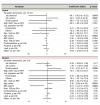The Impact of Job-Demand-Control-Support on Leptin and Ghrelin as Biomarkers of Stress in Emergency Healthcare Workers
- PMID: 36501040
- PMCID: PMC9741408
- DOI: 10.3390/nu14235009
The Impact of Job-Demand-Control-Support on Leptin and Ghrelin as Biomarkers of Stress in Emergency Healthcare Workers
Abstract
Despite the available literature on the consequences of night shiftwork on stress and food intake, its impact on leptin and ghrelin has never been studied. We previously demonstrated that leptin and ghrelin were biomarkers related to stress, and acute stress-induced a decrease in leptin levels and an increase in ghrelin levels. We performed a prospective observational study to assess the influence of night work, nutrition, and stress on the levels of ghrelin and leptin among emergency healthcare workers (HCWs). We took salivary samples at the beginning of a day shift and/or at the end of a night shift. We also monitored stress using the job demand-control-support model of Karasek. We recorded 24-h food intake during the day shift and the consecutive night shift and during night work and the day before. We included 161 emergency HCWs. Emergency HCWs had a tendency for decreased levels of leptin following the night shift compared to before the dayshift (p = 0.067). Furthermore, the main factors explaining the decrease in leptin levels were an increase in job-demand (coefficient -54.1, 95 CI -99.0 to -0.92) and a decrease in job control (-24.9, -49.5 to -0.29). Despite no significant changes in ghrelin levels between shifts, social support was the main factor explaining the increase in ghrelin (6.12, 0.74 to 11.5). Food intake (kcal) also had a negative impact on leptin levels, in addition to age. Ghrelin levels also decreased with body mass index, while age had the opposite effect. In conclusion, we confirmed that ghrelin and leptin as biomarkers of stress were directly linked to the job demand-control-support model of Karasek, when the main cofounders were considered.
Keywords: ghrelin; leptin; nutrients; quality of life; well-being; work.
Conflict of interest statement
The authors declare no conflict of interest.
Figures



References
-
- Dutheil F., Danini B., Bagheri R., Fantini M.L., Pereira B., Moustafa F., Trousselard M., Navel V. Effects of a Short Daytime Nap on the Cognitive Performance: A Systematic Review and Meta-Analysis. Int. J. Environ. Res. Public Health. 2021;18:10212. doi: 10.3390/ijerph181910212. - DOI - PMC - PubMed
-
- Karasek R.A. Job Demands, Job Decision Latitude, and Mental Strain: Implications for Job Redesign. Adm. Sci. Q. 1979;24:285–308. doi: 10.2307/2392498. - DOI
Publication types
MeSH terms
Substances
LinkOut - more resources
Full Text Sources

